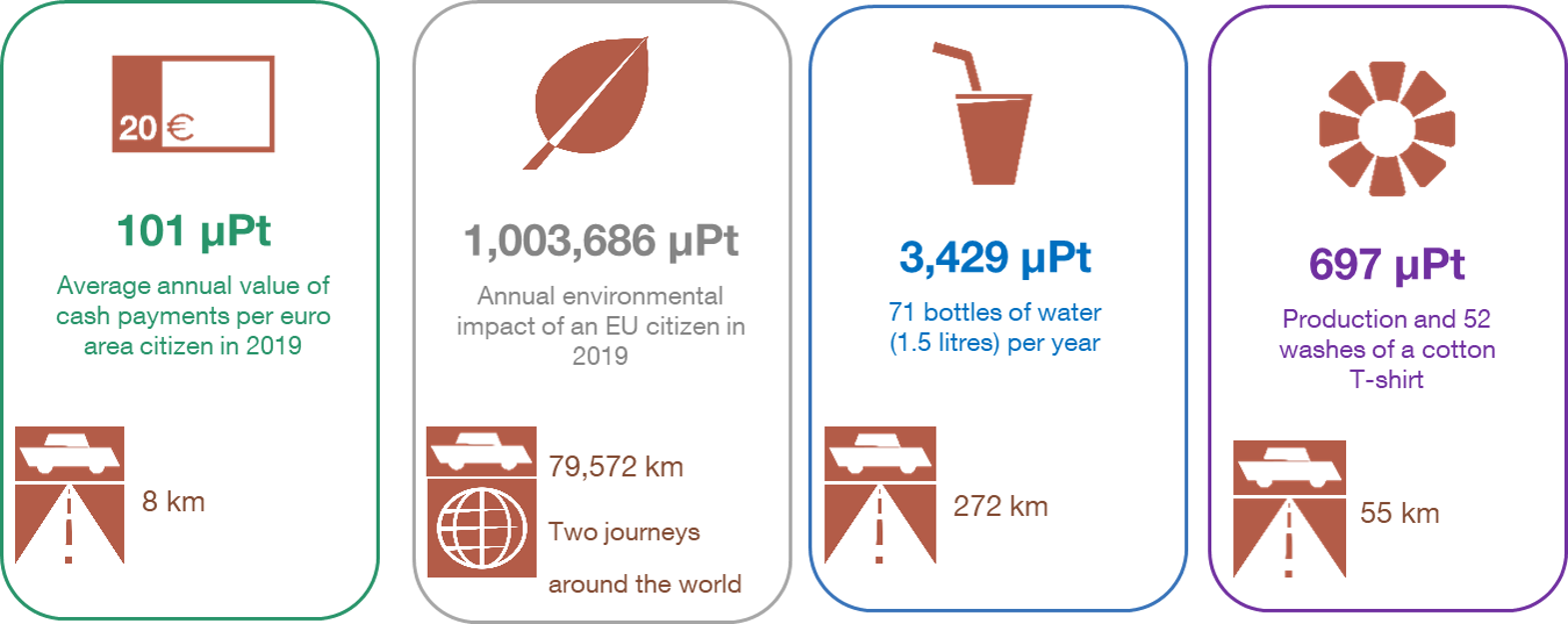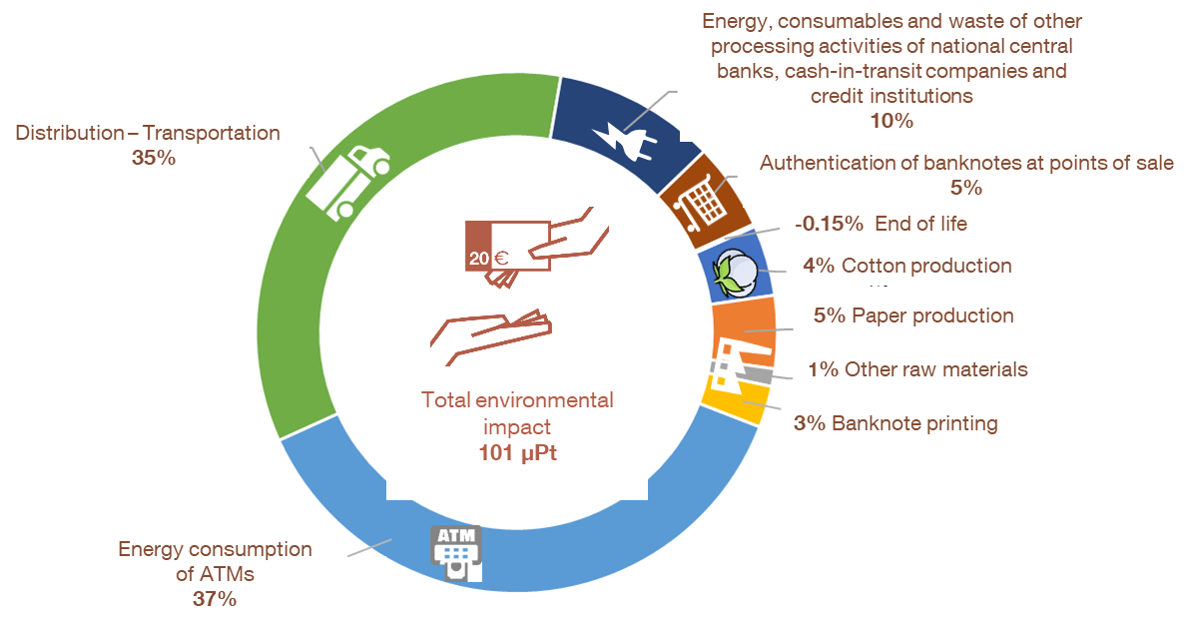How green are our banknotes? The environmental impact of the euro
Cash is still the most common means of payment in shops. But how sustainable is it? The ECB has calculated the environmental impact of euro banknotes. As it turns out, they are green and their environmental impact is being reduced.
Cash or card? How often have you been asked this recently? Cash (including banknotes) is still the most common form of payment in stores, both in Spain![]() and the euro area
and the euro area![]() . In these times of concern about environmental degradation and climate change, you too may have wondered about the environmental impact of your banknotes, compared with the increasingly popular alternatives such as payment by card or mobile phone. Our banknotes are already environmentally friendly, and they will be more so going forward. Here we explain how.
. In these times of concern about environmental degradation and climate change, you too may have wondered about the environmental impact of your banknotes, compared with the increasingly popular alternatives such as payment by card or mobile phone. Our banknotes are already environmentally friendly, and they will be more so going forward. Here we explain how.
Paying for purchases with a banknote is the last step in a complex process, running from manufacture of the banknote to when we withdraw it from a bank or an ATM. The ECB recently analysed![]() the environmental impact of this production and distribution process with two aims: to be able to measure it accurately and help reduce it.
the environmental impact of this production and distribution process with two aims: to be able to measure it accurately and help reduce it.
The environmental footprint of banknotes in comparative terms
The ECB aimed to be fully transparent and objective, using the Product Environmental Footprint (PEF) methodology which is defined and endorsed by the European Commission![]() and offers numerous advantages:
and offers numerous advantages:
- it is used for a wide range of products;
- it covers all stages of the production and distribution process;
- it analyses all the possible environmental impacts (climate change, radiation, drought, etc.);
- the data and outcome must be validated by an independent expert.
One great advantage of this methodology is that highly complex calculations can be converted into a final number, measured in micropoints (µPt). The environmental impact of euro banknotes can thus be compared with that of other products. Above all, it also allows us to gauge the success of the improvements made in the design, production and distribution of euro banknotes.
The environmental footprint of a person’s yearly use of euro banknotes to pay for their usual purchases is equivalent to driving 8 km by car
The ECB study![]() specifically measures the environmental impact of an average European citizen paying for their usual purchases with euro banknotes for a whole year.
specifically measures the environmental impact of an average European citizen paying for their usual purchases with euro banknotes for a whole year.
The study shows that the impact is very low, precisely 101 micropoints. But what does this figure tell us? To help us understand it better, the study compares it with other goods and uses, as shown in Figure 1.
Figure 1
THE ENVIRONMENTAL FOOTPRINT OF EURO BANKNOTES COMPARED WITH OTHER COMMON PRODUCTS

SOURCE: ECB.
NOTE: The µPt or micropoint is the unit of measure of the environmental footprint. It is compared in each case with the equivalent impact of driving a car.
The comparison shows that the impact of using euro banknotes for a year is equivalent to driving 8 km by car, much less than wearing a T-shirt or drinking bottled water for a year. In fact it is barely 0.01% of the total impact of an average person’s routine activity over a year.
What determines the environmental impact of banknotes? What are we doing to reduce it?
By analysing the entire lifecycle of banknotes we can reduce their environmental footprint even more. Banknotes are reused plenty of times over their lifecycle so they are printed to last.
The durability of banknotes means that, when measuring their environmental impact, the distribution stage is more important than the actual production stage. This is typical in any product that is reused and has no negative connotations. Quite the opposite in fact, as it would be unsustainable if, after we paid once with a banknote, it was so damaged that it had to be replaced with a new one.
Figure 2 shows that the distribution stage – mostly transportation and electricity at ATMs, in a roughly equal share – accounts for 82% of the footprint.
Figure 2
BREAKDOWN OF THE ENVIRONMENTAL IMPACT OF EURO BANKNOTES

SOURCE: ECB.
From 2027, when only organic cotton will be used, the footprint will be even smaller
Being able to trace the footprint of euro banknotes has led and will continue to lead to improvements:
- The use of sustainable cotton by Eurosystem
 central banks has already reduced the impact of banknotes to less than 100 micropoints. In 2023 only sustainable cotton was used in banknote production, whereas the study data refer to 2019. By 2027, when only organic cotton (an even more sustainable variant) will be used, the footprint will be smaller still.
central banks has already reduced the impact of banknotes to less than 100 micropoints. In 2023 only sustainable cotton was used in banknote production, whereas the study data refer to 2019. By 2027, when only organic cotton (an even more sustainable variant) will be used, the footprint will be smaller still. - The reduction in energy consumption at ATMs and increased renewable energy generation has cut ATMs’ contribution to the banknote footprint very significantly, and this trend will continue.
- New armoured cash-in-transit vehicles that use hybrid technology or with more sustainable consumption are already a reality.
- The recycling of euro banknotes at the end of their lifespan, as fuel, insulation or raw material for other products, makes them a circular product, as they originate from cotton waste from the textile industry.
In short, we Europeans can be proud of our banknotes. Not only because they are a tangible symbol of the European Union, but also because they give us the opportunity to choose how we want to pay for our purchases. And now we also know that using euro banknotes has a minimal environmental impact and that their footprint will continue to shrink.
DISCLAIMER: The views expressed in this blog post are those of the author(s) and do not necessarily coincide with those of the Banco de España or the Eurosystem.

